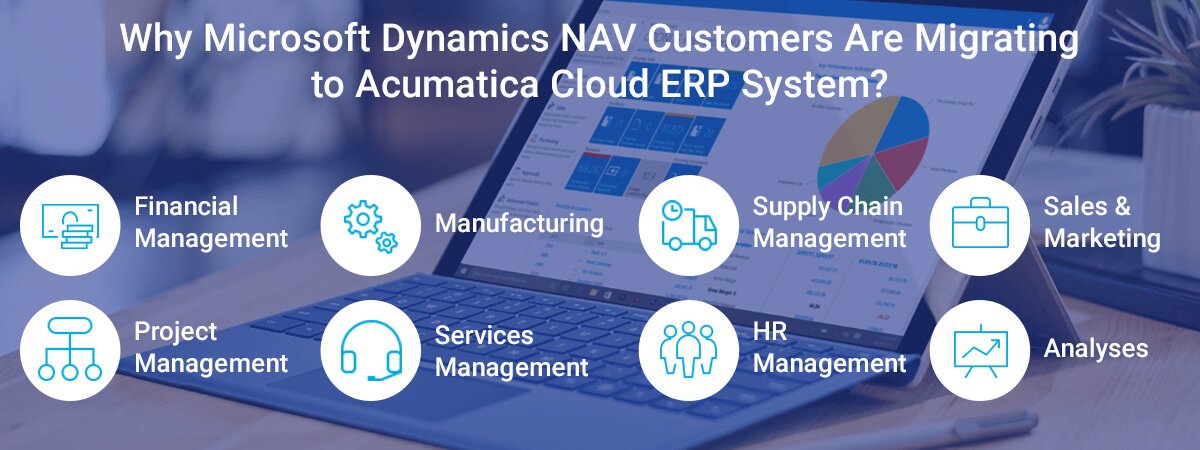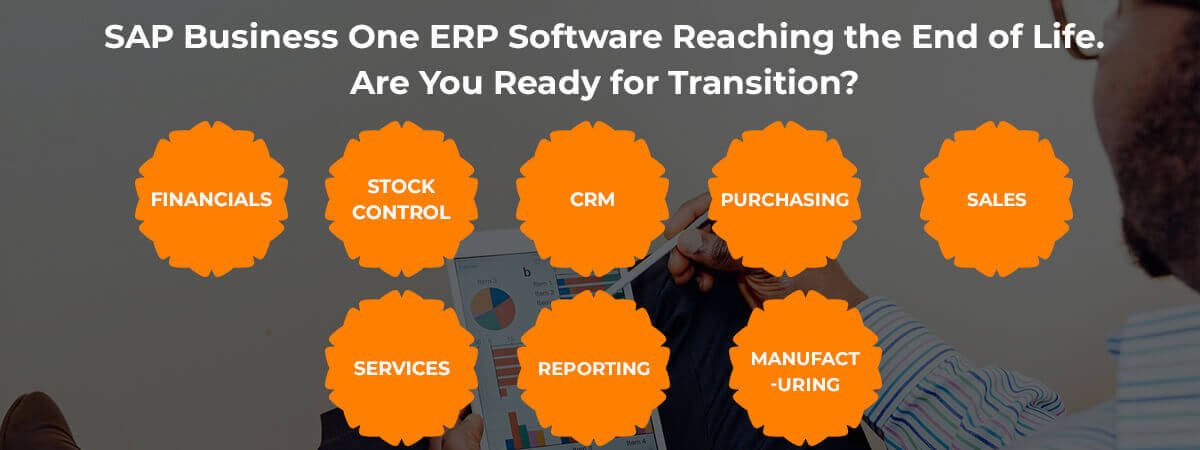The time has arrived for Microsoft Dynamics NAV users to make a rational decision for a new ERP implementation to access distinctive capabilities and thrive in the digital economy. While this ERP product made several enhancements over the years, it still uses the same proprietary code, the same client-server architecture, and the same data structures. Its obsolete architecture could be a big issue for the newest technologies, such as cloud deployment options, CRM integration, and customisation using development tools. Microsoft has redesigned NAV to ensure cloud compatibility and rebranded it as Microsoft Dynamics 365 Business Central. However, it still utilises the old software, and upgrading to Business Central will require rewriting customisation which is an expensive affair. Comparing Acumatica vs Microsoft Dynamics 365 Business Central Microsoft Dynamics 365 Business Central (formerly Dynamics NAV) is a mid-market ERP product that offers: Customizability Third-party software support Support for vertical industries Cloud and on-premises deployment options However, there are drawbacks to Business Central: NAV users must rewrite many of their customizations before moving to Business Central after the Spring 2019 release. Business Central users can’t request a copy of their production database. Many of the third-party solutions available for NAV are not available yet for Business Central. Acumatica offers significant features and capabilities over Business Central. Take a look at how Acumatica compares with Dynamics 365 Business Central: Are you looking for the right business management software? Thousands of companies are moving to the Acumatica Cloud ERP system to gain a competitive edge, reduce upfront costs, and streamline business operations. Microsoft Dynamics NAV offers several benefits listed as: Flexibility and customisation Extensive support for different industries Third-party software support Acumatica ERP provides these same capabilities, but it comes with significant features and functionality that MS NAV doesn’t. Further, we will do a comparison between Acumatica ERP and Microsoft Dynamics NAV to show you how they differ. True CloudAcumatica was built in the cloud right from the beginning and it works with both on-premises or in the cloud without any additional software or equipment. On the contrary, MS Dynamics NAV is an old client-server product and wasn’t designed for the cloud. It can be hosted on a remote server that needs a web server add-up for web support. Customisations with Industry-Standard ToolsBoth software products are configurable, however, Acumatica ERP is developed using industry-specific C# and .NET. Since MS Dynamics NAV utilises the old proprietary code, customisations may become daunting and costly. FlexibilityAcumatica ERP is a complete, multi-site system that can be accessed using web-enabled devices, from any location at any time. Every screen gives the same data and flows, no matter whether it’s a PC, mobile phone, or tablet. On the other hand, MS NAV needs coding to resize pages for different screens, sizes, and resolutions. Deployment OptionsAcumatica ERP supports multiple deployment options, including cloud, on-premises, and hybrid. However, as MS Dynamics NAV is built on old technology, it cannot run in the public cloud. The only choice NAV users have is to run it on-premises or use a private hosting vendor.Moreover, because NAV needs additional web servers to permit cloud configuration and custom pages are resized to support tablet and phone access, the total cost of ownership (TCO) also increases for cloud options. Adapt to Business GrowthCompanies should choose an ERP solution for both current needs and the future. Acumatica ERP doesn’t charge by users, just for computing power required which gives unlimited user accessibility. On the other side, Dynamics NAV is licensed by a user and as your firm grows, you will have more employees, suppliers, and customers so costs will increase fast. How Acumatica Cloud ERP Software Beats Microsoft Dynamics NAV?As we have discussed above, Microsoft Dynamics NAV still uses old technology at its core and on-premises NAV users need to pay a huge amount to meet its new Business Central requirements. [On the contrary, Acumatica ERP was designed to be accessible through the cloud, using scalable and modern web technology to completely integrate CRM and ERP solution on a budget, whether deployed in the cloud or on-premises. Acumatica ERP offers best-in-class functionality, superior performance, ease of use, and best value to small and mid-sized enterprises. It provides a consistent environment across the organisation with no downtime, which enhances productivity and gives one database that you can access anywhere. With the potential changes Microsoft has announced for NAV users, Acumatica ERP is a great alternative to meet or exceed your business requirements today and in the future. About Microsoft Dynamics 365 Business Central Business Central is based on Dynamics NAV. Dynamics NAV was originally developed in the 1980s. Although many improvements have been made to NAV to run in the cloud as Business Central, at its core it still relies on old software techniques and architectures. Conversely, Acumatica was designed from the start to be accessible through the cloud using current technology. This lets Acumatica offer more features and functions than Business Central. In addition, Acumatica offers a completely integrated ERP and CRM solution for the price of resources consumed. And with Acumatica, you enjoy unlimited users for a single annual fee. We believe Acumatica provides the best price/value, performance, functionality, and ease of use of any ERP product available for small- and medium-sized businesses. See the G2 Crowd survey showing how users compared Acumatica against Microsoft Dynamics NAV, GP, and 365. Make sure you take some time to review Acumatica’s ERP software selection resources to help you find the ERP solution that is right for you. Watch this quick (3 minute) demonstration of Acumatica in action. Other Comparison Reports
SAP Business One is an Enterprise Resource Planning (ERP) solution designed for small and mid-sized companies to help manage their business operations. However, the latest update is that the mainstream maintenance for SAP Business One 9.3 version lost its support on June 30, 2020, for both MS SQL and SAP HANA. In an addition, the latest version 10.0 will also experience the same two years later. This means when you upgrade the software to version 10.0, you certainly need to upgrade it again as soon as workflows and customisations are configured. Irrespective of the SAP Business One version you’re using, you will be required to perform an upgrade or need to switch to a new system every 18-24 months. Keeping this in mind, it’s best to make your business ready for today and the future with the Acumatica Cloud ERP system. What is Meant by SAP Business One End of Mainstream Maintenance? The end of mainstream maintenance means SAP will no longer offer new corrections, new functionality, technology updates, legal changes, and further patches. It could be hard for users especially non-tech savvy to upgrade internal resources to create patches and remain on the edge to maintain the entire system. These situations may result in a significant increase in the total cost of ownership. At the end of the mainstream maintenance for SAP Business One 9.3, the following situations are possible: No corrections, no patches, and no new functionality from SAP. You require internal resources and a budget for standard maintenance support. Third-party support is needed for maintenance operations, which can be an expensive and time-consuming affair. SAP users will have less IT budget flexibility as a fraction of the cost is spent on system maintenance activities. Moreover, on-premise SAP users might experience several challenges once the maintenance requirements are no longer on the board. In such cases, switching to Acumatica ERP software is an excellent choice as it is a complete, multi-site solution built on the cloud and requires no additional hardware or software. Why Consider Scaling Your Business with Acumatica ERP Software? In an absolute need for intelligent and scalable technology, Acumatica Cloud ERP is one such fully integrated business platform allowing businesses to transform by managing workflows seamlessly. The best-in-class functionality, superior usability, and customisation options keep security at the highest level and deliver industry-specific benefits to manage key business aspects. Here’s how Acumatica ERP benefits your business in the digital economy: Inventory Tracking Acumatica ERP supports efficient inventory management and proper purchasing process which ultimately prevents inventory shortages, overstock, and delays. With a cloud-based ERP system, the entire process can be managed through built-in modules and functionality. Enhance Productivity Replacing manual processes with a modern Acumatica ERP system simplifies your operations and improves processes with automated workflows. It offers full-function modules like CRM, manufacturing, accounting, order processing, and more – all tailored to the requirements of emerging SMEs. Access Business Information from Anywhere Acumatica cloud ERP software provides 24/7 access to business information from any smart device, anywhere at any time. Information automatically responds to various screen sizes, resolutions, and orientations, which means the interface and workflow are balanced properly. Improve Cash Flow Advanced ERP systems can help reduce human errors and data duplication which enhance order fulfilment and cash flow. It offers accuracy and flexibility to support invoicing with contracts, recurring billing, and deferred billing to meet precise customers’ needs. Adapt to Change Today’s customers incline more towards better and quick service. That’s why Acumatica ERP is the best answer as it is a scalable solution that integrates all technologies your business needs to automate front office and back-office tasks. How to Take the Pain Out of SAP Business One? No matter how flexible the SAP Business One platform may be, the fact remains that software itself has reached the end and you may face serious challenges and failures in the future. With the end of mainstream maintenance by SAP, the time has arrived for customers who have been using ERP solution on-premise to make a smart move to the Acumatica cloud-based ERP solution. With this, you can have complete control over your business processes and boost overall productivity.

